 There are standard depictions of Jesus that show a Caucasian male with blue eyes (some pictures have the occasional brown eyes), shoulder length brown hair, and usually wearing a tunic with sandals. Jesus’ demeanor is usually victorious, prayerful, inviting, and even reflects humility. Our culture creates an unrealistic depiction of Jesus so that in the United States (at least), we see a savior as a white male representative of the power structures that permeate every facet of life.
There are standard depictions of Jesus that show a Caucasian male with blue eyes (some pictures have the occasional brown eyes), shoulder length brown hair, and usually wearing a tunic with sandals. Jesus’ demeanor is usually victorious, prayerful, inviting, and even reflects humility. Our culture creates an unrealistic depiction of Jesus so that in the United States (at least), we see a savior as a white male representative of the power structures that permeate every facet of life.
There are some variations of this image. The most common is this same image with dark skin. A depiction that makes Jesus more tangible to people of color. If we can accept this variation of Jesus, then why would we be upset when images become more culturally tangible, send a message that encapsulates Jesus’ ministry, or make us stop and think – challenging us to take our rose colored glasses off. When an artist creates an image of Jesus that is different than the standard described above, controversy occurs at varying levels. The artwork is removed or de-commissioned, protests occur, and in extreme cases, the artist will even receive death threats. Here is a small sampling of images:
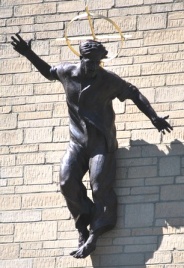
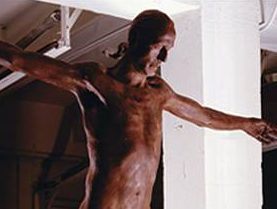
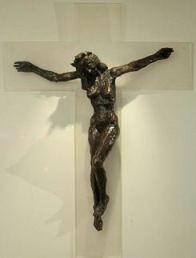
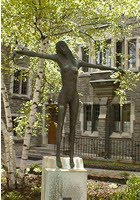
Alternative images of Jesus “puncture the illusion of normalcy” and, for some who are very uncomfortable with these images, are considered “blasphemous.” According to artist, Timothy P. Schmalz, “in certain ways, Christian communities have been privileged and considered themselves the norm in society and that has made Christians comfortable in our complacency.” I agree with this statement. We, as a society, have a bad habit of ignoring the things that make us uncomfortable. I believe that when we are confronted with these images, we are stretched and taken out if our comfort zone. We have the potential not only to be transformed by that experience, but also to make a meaningful difference in someone’s life.
Schmalz created this sculpture of Jesus, which was rejected by two large Catholic Churches, St. Michael’s Cathedral in Toronto and St. Patrick’s Cathedral in New York, because of the potential controversy that could occur because the image deviates from the norm and could confuse people. Ultimately, the sculpture of a homeless Jesus had no home a Jesuit College stepped up and welcomed this depiction. In this story, I have a hard time grasping why a church would have such a concern over this statue. Certainly people have the ability to make the leap to see Jesus depicted this way. Even if someone is confused, it is in that moment they begin to think, even reflect upon the image in front of them. How is that a bad result?
Further, I suggest that Schmalz’s sculpture of “Homeless Jesus” is a closer depiction of what Jesus should represent to all of us. The statue can be shocking for some, but I love the fact that this image is without gender or race making it tangible to anyone that encounters this image.
The artist was inspired by Matthew 25:31-46 (The Judgment), which states (in part):
“But when the Son of Man comes in His glory, and all the angels with Him, then He will sit on His glorious throne. All the nations will be gathered before Him; and He will separate them from one another, as the shepherd separates the sheep from the goats; and He will put the sheep on His right, and the goats on the left. “Then the King will say to those on His right, ‘Come, you who are blessed of My Father, inherit the kingdom prepared for you from the foundation of the world. For I was hungry, and you gave Me something to eat; I was thirsty, and you gave Me something to drink; I was a stranger, and you invited Me in; naked, and you clothed Me; I was sick, and you visited Me; I was in prison, and you came to Me.’
Then the righteous will answer Him, ‘Lord, when did we see You hungry, and feed You, or thirsty, and give You something to drink? And when did we see You a stranger, and invite You in, or naked, and clothe You? When did we see You sick, or in prison, and come to You?’ The King will answer and say to them, ‘Truly I say to you, to the extent that you did it to one of these brothers of Mine, even the least of them, you did it to Me………….’
(New American Standard Bible)
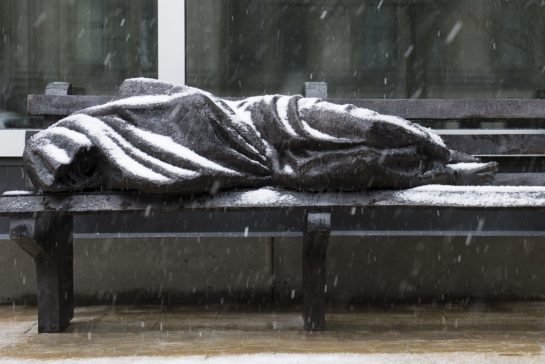
Homelessness is a theme throughout Jesus’ life. When Jesus was born, it was in a stable. Shortly afterward, his family fled to Egypt seeking asylum. When Jesus began his public ministry, he relied on the hospitality of others and did not have a permanent home of his own. Moreover, the focus of Jesus’ earthly ministry was to reach out to the homeless, poor, and oppressed. The parable of the good Samaritan (Luke 10:25-37) and the parable of the rich man and and Lazarus (Luke 16:19-31) also reflect this concern for the homeless. One could even argue that the homeless and impoverished are usually treated poorly and live on the outskirts of society, which is also a way we see Jesus depicted in scripture.
People want to ignore, walk past, and even step-over the homeless. The familiar faces of the homeless seen daily in the cities streets can become so familiar, we fail to be impacted. Ignoring the problem and turning a blind eye is easy for most. One can pretend that the homeless and poor do not exist, but encountering this sculpture serves as a stark reminder that they do exist. When you see the puncture wounds on the feet, we are reminded that the person we ignore could very well be Jesus. This is also a reminder that in the homeless, we can see God – after all we are all made in the image of God. So to ignore the homeless is essentially the same thing as ignoring God.
So, if being homeless is an accurate characterization of Jesus, why, when we see this depiction, are we shocked? How is this image controversial? Does it make people uncomfortable to see the Son of God this way? If it does, good. Maybe in that moment our hearts, regardless of whether we are Christian, will be opened and, in some way, positive change can occur.
Being uncomfortable or shocked is not a bad thing, especially if it starts dialogue and raises awareness to a problem. We know that people learn in a multitude of ways; the same is true about faith. How we pray, how we encounter the divine and ourselves, and what we believe is impacted by our experiences. For this artist, the image becomes a type of visual prayer that reaches out to everyone; secular, homeless, other religions, as well as Christians.
This sculpture calls us to reflect and remember that we are to love all of humanity and everyone, no matter their status in life, must be treated with dignity. We are commanded to reach out to help our fellow humans, not only at Thanksgiving, but everyday.
The artist stated that he would like see more of these sculptures throughout the city, in the hope of sensitizing and reminding people to care for the homeless. Can we as society handle seeing more representations of Jesus around? Will this association make us more compassionate or do we, as a society, continue to ignore the problem and continue to exist in a protected and privileged environment?
Michele Stopera Freyhauf is currently a Doctoral Student in the Department of Theology and Religionat Durham University. She has a Master of Arts Degree from John Carroll University in Theology and Religious Studies, is a Member of Sigma Nu, performed post-graduate work in History focusing on Gender, Religion, and Sexuality at the University of Akron, and is an Adjunct Instructor in the Religious Studies Department at Ursuline College. Her full bio is on the main contributor’s page or at http://durham.academia.edu/MSFreyhauf. Michele can be followed on twitter at @msfreyhauf.


MIchele, you ask the question: “Even if someone is confused, it is in that moment they begin to think, even reflect upon the image in front of them. How is that a bad result?”
One of the many reasons I left the church behind, is because they don’t want people to think! They don’t want people to have their individual understanding of who Jesus is to them.
LikeLike
actually, the priests at the churches WANTED the sculpture, and it was the bishop who axed it. i think this is an important point.
LikeLike
Interesting post.
I think the the “shock value” in these images and the theological value of them as well depends on thinking of Jesus as the (sole) prototypical human.
If Jesus is simply one interesting and influential person among others (low or no Christology), then maybe we should let him be a Jew of his time, probably short and olive-skinned with black hair.
I mean should we be portraying Martin Luther King as a woman or Rosa Parks as a man? Or either of them as any color other than black? Only if one of them is our one and only image of what it is to be human.
LikeLike
Fascinating point, Carol. Good question to raise.
If we were to depict him in his own time and context, homelessness is certainly an aspect of his historic presentation.
LikeLike
What I can’t understand is any standard picture or sculpture of Jesus nailed to that awful cross. Why do people worship suffering? Yes, this is one of the basic tenets of the Christian church: that life on earth is a life of suffering. That’s why so many of the so-called saints went out of their way to get themselves killed in interesting but nasty ways. Martyrdom was a good thing. Just read the news: it’s still a favorite pastime of some people,a favored way to leave this earth. Why can’t we have a happy Jesus who, yes, looks like a Jew who lived in the Roman colony of Judea?
LikeLike
I agree, Barbara. It is time to stop wanting to die as a martyr and start wanting to live as a happy person.
LikeLike
I am not shocked by these images. But then again, I am not American, and then again, I am not Christian. However, let me tell you something funny: for a while now I have been collecting photos of statues of the Buddha, which I find in most incredible places: from a vacuum cleaners shop window (next to vacuum cleaners), to a bar that sells alcohol. (And I’m not even mentioning the highly artistic garden gnome Buddhas :-) And I’ll tell you what: these do not shock me either. I just smile and I hope that images of the Buddha will bring peace, calm and accord between people and all sentient beings, wherever these images are erected.
LikeLike
Great article – thank you for making us think!
I agree with Barbara and Oxana.
I’ve always wondered why Jesus is depicted as predominantly ‘white’. And why symbolised on the cross. Thousands of people were crucified, for many reasons. It wasn’t special to Jesus. I wonder what he would think of our time and cultures? I’m not sure he’d be too happy… in 2000 years, what’s changed? Persecution still, prejudice, bigotry…
LikeLike
Perhaps as interesting as people’s responses to “shock value” Jesuses is their response to realistic portrayals. A somewhat scruffy “Arab-looking” guy does not say “Jesus” to most people.
In response to Carol, a sufficiently “high” christology should also protect from the “shock”. If Jesus is really thought of as God, then like the Godhead “his” maleness, hair colour, etc… are as irrelevant as his food preferences. The Logos Asarkos has no gender, race etc.
LikeLike